|
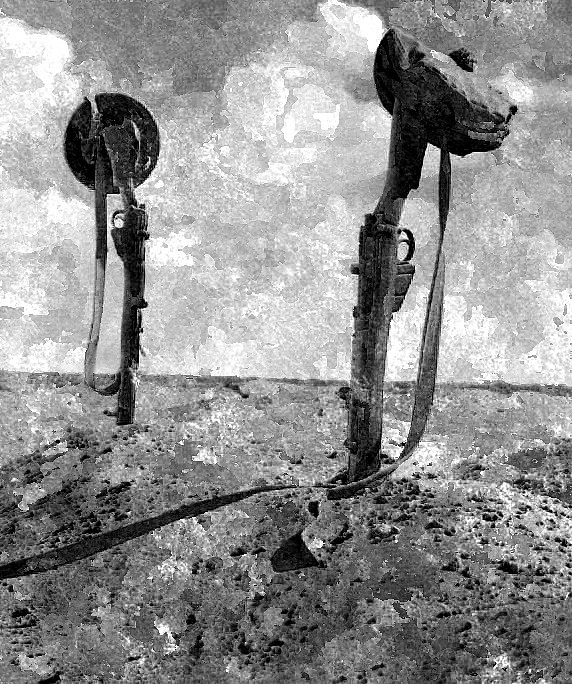
|
“Good-morning,
good-morning!” the General said
When we met him last week on our way to the line.
Now the soldiers he smiled at are most of
’em dead,
And we’re
cursing his staff for incompetent swine.
“He’s a cheery old card,” grunted Harry to Jack
As they slogged up to Arras with rifle and pack.
But he did for them both by his plan of attack.
The General, by
Siegfried Sasoon |
“KITCHENER’S ARMIES”: “Your King and Country need you: a call to arms” was a
recruiting poster published on the 11th August 1914. It
explained the new terms of service and called for 100,000 men to
enlist, a figure that was achieved within two weeks. Army
Order 324, dated 21st August 1914, then specified that six new
Divisions would be created from units formed of these volunteers,
collectively called “Kitchener’s Army” or K1. It
also detailed how the new infantry battalions would be given numbers
consecutive to the existing battalions of their regiment, but with
the addition of the word ‘Service’ after the unit number.

On the 28th August 1914, Kitchener asked for a further 100,000
volunteers. Army Order 382, issued on the 11th September 1914,
specified an additional six Divisions, which were to be called
K2.
They were organised on the same basis as K1, and came under War
Office control. A third 100,000 recruits followed and were
placed into another six Divisions, called K3, to be organised
on the same basis as K1 and K2 under War Office control.
Enough men came forward not only to fill the ranks of K3, but to
form reserves, which were initially formed up into the six Divisions
of K4.
GENERAL PLUMER: of squat figure and ruddy countenance, with monocle and white
moustache, the appearance of Field Marshal Herbert Charles Onslow
Plumer, 1st Viscount Plumer, GCB, GCMG, GCVO, GBE (1857-1932) − as
he later became − sometimes caused amusement, but it belied one of
the most effective and successful First World War generals.
Plumer was a meticulous planner, cautious and impossible to fluster.
He won an overwhelming victory over the German Army at the Battle of
Messines in June 1917, which he followed with further victories at
the battles of the Menin Road Ridge, of Polygon Wood and of
Broodseinde. Plumer later commanded the Second Army during the
German Spring Offensive and the Allied Hundred Days Offensive in the
final stages of the war.
ARMY HIERARCHY:
the following hierarchy, by which the British Army was organised and
controlled at the time of the Great War is not exhaustive, but is sufficient to
cover the terminology used in the accompanying biographical notes.
PLATOON: each battalion
(see below) was divided into four companies (see below). A
company consisted of four platoons, each of about 50 men, under a
Lieutenant or Second-Lieutenant, assisted by a Sergeant.
Within a platoon were four sections of 12 men. A crucial part
of the platoon officer’s job was to care for the welfare of his men,
even down to inspecting their feet daily for signs of trench foot.
COMPANY: a military unit, typically consisting of 80–250 soldiers
and usually commanded by a major or a captain. Most companies
were formed from four platoons named alphabetically A through D.
BATTALION: a military unit typically
commanded by a lieutenant colonel and consisting of
1,000 men divided into four companies plus a machine
gun section. In
addition to consisting of sufficient personnel and equipment
to perform significant operations, as well as a
limited self-contained administrative and logistics capability, the
commander was provided with a full-time staff whose function was to
coordinate current operations and plan future operations.
REGIMENT: during
peacetime is the key administrative component of the British
Army and the largest permanent organisational unit. It
is typically commanded by a colonel and divided into two or more
battalions, which during war do not necessarily fight
together.
BRIGADE: a major tactical military formation typically
comprising three to six battalions plus supporting elements
and commanded by a Brigadier.
Two or more brigades may constitute a division.
DIVISION: a large military unit or formation, usually
commanded by a major-general and consisting
of between 10,000 and 20,000 soldiers. Infantry divisions during the
World Wars ranged between 10,000 and 30,000 in nominal strength
comprising several regiments or
brigades possessing a range of specialities − Headquarters staff;
Infantry; Artillery; Ammunition column; Engineers; Signals; Medical;
Logistics and Cavalry.
CORPS: in military terminology a corps
(not to be confused with military units that had
‘corps’
in their title, such as Royal Army Medical Corps) was an operational
formation, usually commanded by a lieutenant-general, consisting of
two or more divisions. When the British Army was expanded from an
expeditionary force in the First World War, corps were created to
manage the large numbers of divisions.
ARMY: a field army (or numbered army, or simply army) is a military
formation in many armed forces, composed of two or more corps and
may be subordinate to an army group usually commanded by a general. A field army is composed
typically of 100,000 to 150,000 troops.
SERVICE BATTALIONS: in August 1914 Lord Kitchener called for
more men to fight, and by September half a million men had enlisted.
Known at the time as Kitchener’s Army, the new army consisted of
over 500 battalions. They were numbered consecutively after
the existing battalions of their regiment and were distinguished by
the word “service”, this indicating that they were intended to serve
only for the duration of the war.
MACHINE GUN CORPS: at the outbreak of war, each infantry battalion and cavalry regiment
had a machine gun section equipped with just two guns served by a
subaltern and 12 men. Battle
experience soon revealed that to be fully effective machine guns
needed to be used in larger units crewed by men who were thoroughly
conversant with their weapons and who understood how they should be
deployed for maximum effect. To achieve this the MGC was
formed, with Infantry, Cavalry, and Motor branches, followed in 1916
by a Heavy Branch. The Infantry Branch was by far the largest
and was formed by the transfer of battalion machine gun sections to
the MGC, these sections being grouped into Brigade Machine Gun
Companies with three per division, later increased to four.
In 1914, machine gun sections were equipped with Maxim guns, by then
obsolete. Shortly after the formation of the MGC, the Maxim
guns were replaced by the Vickers, which became a standard gun for
the next five decades. The Vickers machine gun is fired from a
tripod and is cooled by water held in a jacket around the barrel.
The gun weighed 28½ pounds, the water another 10 and the tripod
weighed 20 pounds. Bullets were assembled into a canvas belt,
which held 250 rounds and would last 30 seconds at the maximum rate
of fire of 500 rounds per minute. Two men were required to
carry the equipment and two the ammunition. A Vickers machine
gun team also had two spare men.
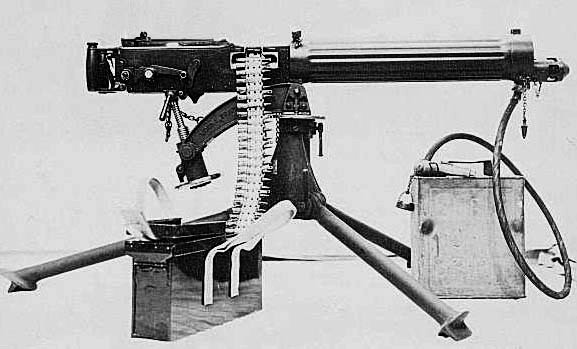
Vickers machine gun with ammunition and
water-cooling.
In its short history − it was disbanded in 1922 − the MGC gained an
enviable record for heroism as a front line fighting force, but had
a less enviable record for its casualty rate. Some 170,500
officers and men served, with 62,049 becoming casualties, including
12,498 killed, earning it the nickname “the Suicide Club.”
LEWIS GUN: a First World War-era
shoulder-held air-cooled light machine gun of US design that was
perfected and mass-produced in the United Kingdom. It was
widely used during both world wars – as an aircraft machine gun
almost always with the cooling shroud removed – and served until the
end of the Korean War.
The Lewis weighed 26 pounds and
loaded with a circular magazine containing 47 rounds.
The rate of fire was 500–600 rounds per minute in
short bursts. The weapon was carried and fired by one
man, but he needed another to carry and load the
magazines.
Cartridge (British) .303; Rate of fire 500–600 rounds/min; Effective
firing range 880 yards.

Above: the Lewis light machine gun:
Below, Lewis Limber.

SPECIAL RESERVES: the Reserve Forces Act (1907) was intended
to provide a well-trained reserve for the Regular Army that was
capable of providing individual reinforcements or drafts at short
notice as well as an efficient and cost effective Home Defence
organisation. Before the introduction of the Reserve Forces
Act, Home Defence was the responsibility of the Volunteer Battalions
and the Yeomanry and the Reinforcement of the Regular Army was the
responsibility of the Militia. Thus, the Special Reserves was
a form of part-time soldiering in which men would enlist for 6
years. Their service began with six months full-time training
(paid the same as a regular) after which they received 3 to 4 weeks
training per year.
FIELD MARSHALL ALLENBY (1st Viscount Allenby, 1861–1936): fought
in the Second Boer War and in the First World War. After
periods in command of the British cavalry and the 5th Corps, he
became commander of the 3rd Army in October 1915 and was prominently
engaged at the Battle of Arras (9th April-16th May 1917), following
which he was transferred to Egypt. Although Allenby regarded
this transfer as a badge of failure, his service in the Middle East
was to prove most distinguished. In June 1917 he took command
of the Egyptian Expeditionary Force, in which the strength of his
personality lifted moral (Montgomery’s arrival in the Western Desert
was later to have the same effect on his force). After careful
preparation and reorganization he won a decisive victory over the
Turks at Gaza, which led to the capture of Jerusalem on the 9th
December 1917. Further advances were checked by calls from
France for his troops, but after receiving reinforcements, he won a
decisive victory at Megiddo on the 19th September 1918, which,
followed by his capture of Damascus and Aleppo, ended Ottoman power
in Syria.
Allenby’s success in these campaigns was attributable partly to his
skilful and innovative use of cavalry and other mobile forces in
positional warfare. Overall, his defeat of the Ottomans more
than redeemed any reputational setback he suffered in France.
THE BATTLE OF THE BOAR’S HEAD: an attack on the 30th June
1916 at Richebourg-l’Avoué in France. Troops of the British
39th Division of the XI Corps in the First Army, advanced to capture
the Boar’s Head, a salient held by the German 6th Army. Two
battalions of the 116th Brigade, with one battalion providing
carrying parties, attacked the German front position before dawn on
the 30th June. The British took and held the German front line
trench and the second trench for several hours before retiring,
having lost 850–1,366 casualties. In fewer than five hours the
three Southdowns battalions of the Royal Sussex Regiment lost 17
officers and 349 men killed, including 12 sets of brothers, three
from one family. A further 1,000 men were wounded or taken
prisoner. In the regimental history it is known as “The Day
Sussex Died”.
CARRYING PARTIES: carried forward ammunition, equipment, food
etc. from the rear area to the front lines. Providing carrying
parties seems to have been a fate allotted to new battalions
arriving in France and at the front for the first time. It was
part of the process of acclimatising them to the front lines.
Carrying parties could also be detailed as an integral part of
attacking waves, bringing up stores and ammunition, further defence
stores for holding newly won ground or trenches (wire, pickets,
sandbags, revetting material, duckboards and A-Frames) and assisting
with the carriage of machine guns and trench mortars.
YEOMANRY: is a designation used
by a number of units or sub-units of the British Army Reserve,
descended from volunteer cavalry regiments. On the eve of
World War I there were 55 Yeomanry regiments (with two more formed
in August 1914), each of four squadrons instead of the three of the
regular cavalry. Upon embodiment these regiments were either
brought together to form mounted brigades or allocated as divisional
cavalry. For purposes of recruitment and administration the
Yeomanry were linked to specific counties or regions, identified in
the regimental title. Some of the units still in existence in
1914 dated back to those created in the 1790s while others had been
created during a period of expansion following on the Boer War.
THE TERRITORIAL FORCE (TF): was originally formed by
the Secretary of State for War, Richard Burdon Haldane, following
the enactment of the Territorial and Reserve Forces Act (1907).
This combined and re-organised the old Volunteer Force with the
Yeomanry. As part of the same process, remaining units of
militia were converted to the Special Reserve. [Note]
The TF was formed on the 1st April 1908. It comprised fourteen
infantry divisions and fourteen mounted yeomanry brigades, with an
overall strength of approximately 269,000. The first fully
Territorial division to join the fighting on the Western Front was
the 46th (North Midland) Division in March 1915, with divisions
later serving in Gallipoli and elsewhere. As the war
progressed, and casualties mounted, the distinctive character of
territorial units was diluted by the inclusion of conscript and New
Army drafts. Following the Armistice all units of the
Territorial Force were gradually disbanded. New recruiting
started in early 1920, and the Territorial Force was reconstituted
on the 7th February 1920. On the 1st October 1920, the
Territorial Force was renamed the Territorial Army.
|
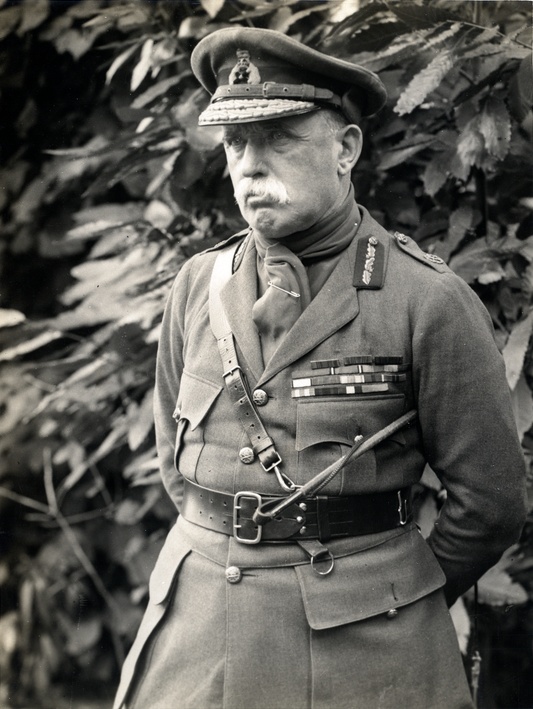 |
|
Field Marshall Sir John
French, pictured August 1915. |
THE HOHENZOLLERN REDOUBT:
a defensive labyrinth of trenches and machine-gun posts, it
protected an important German artillery observation point known as
Fosse 8, and was considered to be one of the strongest positions on
the entire Western Front in 1915. Named after
the House of Hohenzollern, the redoubt was fought over by German and
British forces. Engagements took place from the Battle of Loos (25th
September–14th October 1915) to the beginning of the Battle of the
Somme on the 1st July 1916. On the 13th October 1915, during
the Battle of Loos, the 46th North Midland Division undertook the
main assault on the Hohenzollern Redoubt, resulting in 3,643
casualties within the first ten minutes of action. The British
Official History of the war calls the attack “nothing but the
useless slaughter of infantry”.
FIELD MARSHALL SIR JOHN FRENCH, 1st EARL OF YPRES (1852-1925):
following a varied and distinguished career, which included the
Sudan Campaign of 1884-85 and notable service as a cavalry officer
in the Boer War, French was promoted to Field Marshal in 1913.
From 1912 to 1913 he served as Chief of the Imperial General Staff.
French was appointed Commander of the British Expeditionary Force (BEF)
at the start of World War I. When the line stabilized in 1915,
a series of stalled BEF offensives led to doubts about his
competence. Criticized for his indecisiveness with reserve
forces at the Battle of Loos, French resigned his post in late 1915.
He was created a viscount in 1916 and an earl in 1922, serving as
Commander in Chief of the British home forces and then Lord
Lieutenant of Ireland during those later years.
Despite recent attempts to give French’s strategic thought some
coherency, historians judge him unfit to have commanded at the
highest level.
|
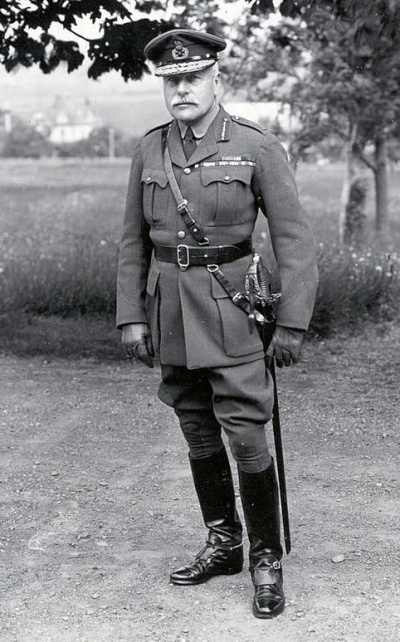 |
|
Field Marshall Haig in 1924. |
FIELD MARSHALL DOUGLAS HAIG, 1st EARL HAIG (1861–1928):
commanded the British Expeditionary Force (BEF) on the Western Front
from late 1915 until the end of the war. He was commander
during the Battle of the Somme – the battle with one of the highest
casualties in British military history – the Third Battle of Ypres,
and the Hundred Days Offensive, which led to the armistice of the
11th November 1918.
Although he gained a favourable reputation during the immediate
post-war years, since the 1960s he became an object of criticism for
his leadership during the First World War, during which the forces
under his command sustained two million casualties.
The Canadian War Museum comments, “His epic but costly offensives
at the Somme (1916) and Passchendaele (1917) have become nearly
synonymous with the carnage and futility of First World War battles.”
However, more recently historians have argued that this criticism
failed to recognise the adoption of new tactics and technologies by
forces under his command, the important role played by British
forces in the Allied victory of 1918, and that the high casualties
were a consequence of the tactical and strategic realities of the
time.
Haig’s military career ended in January 1920, following which he
devoted the rest of his life to the welfare of ex-servicemen.
|
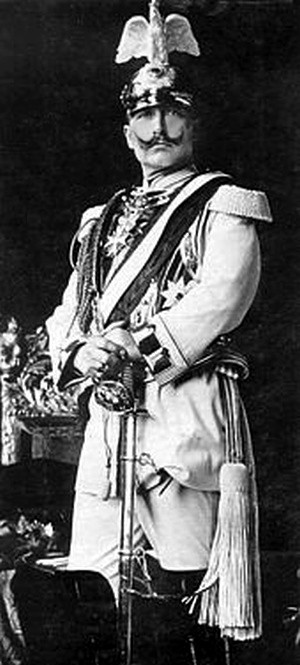 |
|
Kaiser Wilhelm II
(1859-1941) |
THE BRITISH EXPEDITIONARY FORCE (BEF): was an army
established by Richard Haldane, Minister for War, following the
Second Boer War. Its purpose was to ensure that Britain had a
fully trained and prepared army that was able to deploy quickly to
conflicts. At the outbreak of war, the BEF comprised
approximately 120,000 full time soldiers supplemented by a Special
Reserve consisting of members of the territorial army. It
deployed very quickly – the first British troops arrived on the
Western Front just 3 days after the declaration of war with the
remainder of the force following soon after. The BEF, together
with the French army, was able to slow and then stop the German
advance into France and Belgium, but at great cost. By the end
of 1914 the BEF was having to be supplemented by volunteers and
recruits.
At the outset the BEF was commanded by Sir John
French, but he was replaced by Sir Douglas Haig
in December 1916. By then the majority of soldiers deployed in
the Western Front comprised ‘Kitchener’s Army’
recruits and conscripts, along with many soldiers from the Empire.
THE OLD CONTEMPTIBLES: although there is no documentary
evidence of it, it is alleged that on the 19th August 1914, at his
headquarters in Aix-la-Chapelle, Kaiser Wilhelm II gave this order:
“It is my Royal and Imperial Command that you concentrate your
energies, for the immediate present upon one single purpose, and
that is that you address all your skill and all the valour of my
soldiers to exterminate first the treacherous English; walk over
General French’s contemptible little Army.” Hence the British
Expeditionary Force, the B.E.F., became known as The Old
Contemptibles.
THE MESSINES MINES: deep mining beneath Hill 60 began in late
August 1915. When complete, the Hill 60 mine was charged with
53,300 pounds (24,200 kg) of explosives and a branch gallery under
the nearby Caterpillar took a 70,000-pound (32,000 kg) charge.
At 3:10 a.m. on the 7th June 1917 these and other mines – filled in
total with 990,000 pounds (450,000 kg) of explosives – were
detonated under the German lines, the blasts creating one of the
largest explosions in history (reportedly heard in London and
Dublin) killing some 10,000 German soldiers. In total 19 mines
were exploded over a period of 19 seconds, mimicking the effect of
an earthquake and ranking among the largest non-nuclear explosions
of all time. That the detonations were not simultaneous added
to the terrorising effect on German troops, as the explosions moved
along the front. An eye-witness reported:
“The artillery preparations which for days
had been intense had died down and the night was comparatively
quiet. Suddenly, all hell broke loose. It was
indescribable. In the pale light it appeared as if the whole
enemy line had begun to dance, then, one after another, huge tongues
of flame shot hundreds of feet into the air, followed by dense
columns of smoke which flattened out at the top like gigantic
mushrooms. From some craters were discharged tremendous
showers of sparks, rivalling everything ever conceived in the way of
fireworks.”
HALTON PARK: at the outbreak of war the Park, on the
outskirts of Wendover, was offered to the War Office by Alfred de
Rothschild for use as a training camp. The first division to
arrive was the 21st Yorkshire Division, which had its divisional HQ
at Aston Clinton House (demolished in the late 1950s). Halton
House was lent to the Royal Flying Corps, which, from the 1st April
1918 became the Royal Air Force. Devastated by the carnage of
the war, Alfred de Rothschild’s health began to fail and he died in
1918. Having no legitimate children, the house was bequeathed
to his nephew Lionel Nathan de Rothschild who detested the place and
sold it at auction in 1918. The house and by now diminished
estate were purchased for the Royal Air Force by the Air Ministry
for a bargain £115,000.
THE BATTLE OF THE SOMME: during discussions held in December
1915, the French and British committed themselves to an offensive on
the Somme, an area of northern France named after the Somme river.
They agreed on a strategy of combined offensives in 1916, with
initial plans calling for the French army to undertake the main part
of the offensive supported on the northern flank by the Fourth Army
of the British Expeditionary Force (BEF). However, on the 21st
February 1916 German Army launched the Battle of Verdun, resulting
in the French diverting many of the divisions intended for the Somme
to the Verdun theatre, and what in the the plan was to be a
“supporting” attack by the British became the principal effort.
The Battle of the Somme was one of the most bitterly contested and
costly series of battles of the First World War, lasting for nearly five
months. Despite this, it is often the first day of the battle
that is most remembered, for British forces suffered 57,470
casualties (including 19,240 killed), the largest loss ever suffered
by the British Army in a single day.
The offensive began on 1st July 1916 after a week-long artillery
bombardment of the German lines. Advancing British troops
found that the German defences had not been destroyed as expected
and many units suffered very high casualties with little progress.
The Somme became an attritional or ‘wearing-out’ battle. On
the 15th September tanks were used for the first time with some
success, but they did not bring a breakthrough any closer.
Operations on the River Ancre continued with some gains, but in
deteriorating weather conditions major operations on the Somme ended
on the 18th November.
|
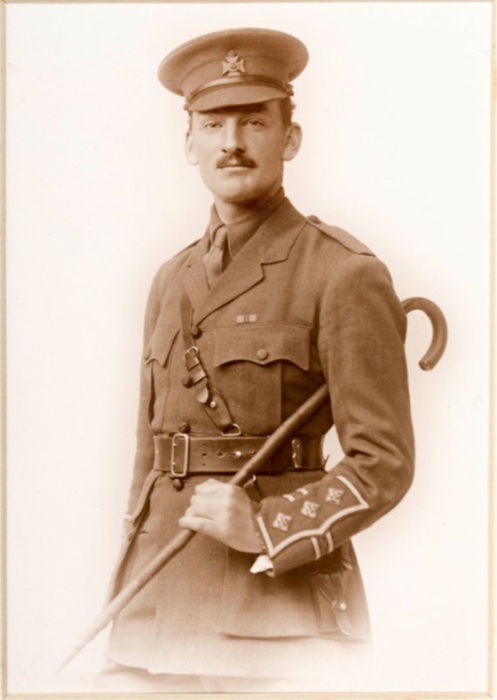 |
|
Captain Lionel William
Crouch (1886-1916) |
Over the course of the 5-month battle, British forces took a strip
of territory 6 miles deep by 20 miles long. But improvements were
made in the use of artillery and infantry tactics, and new weapons,
including tanks, began to be integrated in the British Army’s
methods.
LIONEL CROUCH: son of William Crouch, a Clerk of the Peace to
Buckinghamshire County Council, and Helen Marian Crouch née Sissons.
He had a younger brother Guy R. Crouch (who became a captain in the
1st Bucks Battalion of the British Army and was awarded the Military
Cross) and a sister Doris. The family home was Friarscroft in
Aylesbury.
Lionel was educated at Marlborough College from 1900 to 1904.
Having qualified as a solicitor in 1909, he worked for Horwood and
James in Aylesbury and was also a deputy Clerk of the Peace for
Buckinghamshire. His brother was also a solicitor, with
Parrott and Coales. A keen philatelist, Crouch was
vice-president of the Junior Philatelic Society.
Captain Crouch was an officer in the Oxfordshire and Buckinghamshire
Light Infantry, part of the Territorial Force, before the start of
the First World War. On the outbreak of the war, in July 1914,
the Territorials were mobilised and Captain Crouch left Aylesbury on
the 4th August while his brother Guy and the bulk of the men left
the town by rail the following day. They arrived in Cosham for
training with not a man missing which was a source of pride to
Crouch. His battalion left Chelmsford for the front on the
30th March 1915.
Lionel was shot during an attack on Pozieres on the 21st July 1916.
While being dragged back by his orderly he was hit a second time and
died ten minutes later. He is buried in Pozieres
Cemetary. His father published Lionel’s letters from the front
to him privately under the title
Duty and Service: letters from the front − the
proceeds of the publication he donated to war charities.
MINENWERFER (“mine launcher”): is the German name for a class of
short range mortars used extensively during the First World War by
the German Army. The weapons were intended to be used by
engineers to clear obstacles including bunkers and barbed wire, that
longer range artillery would not be able to accurately target.
It was loaded from the muzzle like a typical mortar, but did have a
rifled barrel and a hydraulic recoil dampening system.
THE 1918 SPRING OFFENSIVE – a.k.a. THE LUDENDORFF OFFENSIVE
(see map below):
was a series of German attacks along the Western Front beginning on
the 21st March 1918. Although ultimately a failure, it was the
nearest the German Army came to a decisive breakthrough on the
Western Front during the entire war.
The Germans realised that their remaining
chance of victory was to defeat the Allies before the overwhelming
human and material resources of the United States could be fully
deployed. They also had the temporary advantage in numbers
afforded by the nearly 50 divisions freed by the Russian surrender
(the Treaty of Brest-Litovsk).
There were four German offensives, codenamed Michael,
Georgette, Gneisenau and Blücher-Yorck.
Michael was the main attack, which was intended to break through
the Allied lines, outflank the British forces which held the front
from the Somme River to the English Channel and defeat the British
Army. Once this was achieved, it was hoped that the French
would seek an armistice. The other offensives were subsidiary
to Michael and were designed to divert Allied forces from the
main offensive on the Somme.
No clear objective was established before the start of the
offensives and once the operations were underway, the targets of the
attacks were constantly changed according to the battlefield
situation. The Allies concentrated their main forces in the
essential areas (the approaches to the Channel Ports and the rail
junction of Amiens), while leaving strategically worthless ground,
devastated by years of combat, lightly defended.
The Germans were unable to move supplies and reinforcements fast
enough to maintain their rapid advance. The fast-moving
stormtroopers leading the attack could not carry enough food and
ammunition to sustain themselves for long and all the German
offensives petered out, in part through lack of supplies.
By late April 1918, the danger of a German breakthrough had passed.
The German Army had suffered heavy casualties and now occupied
ground of dubious value which would prove impossible to hold with
such depleted units. In August 1918, the Allies began a
counter-offensive with the support of large numbers of fresh American
troops, and using new artillery techniques and operational methods.
This Hundred Days Offensive [Note]
resulted in the Germans retreating or being driven from all of the
ground taken in the Spring Offensive, the collapse of the Hindenburg
Line and the capitulation of the German Empire that November.
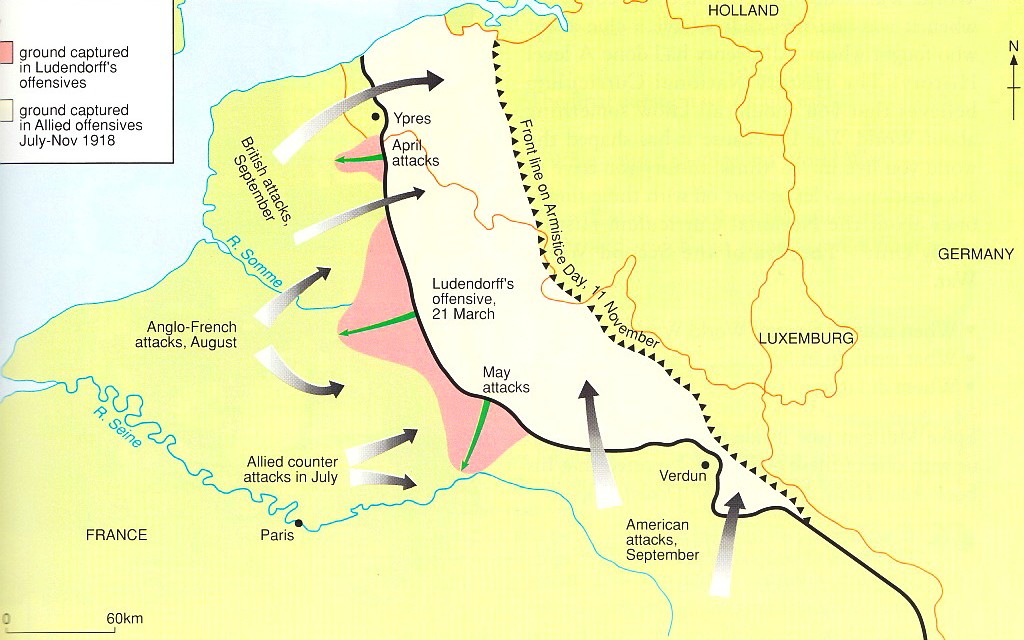
THE HUNDRED DAYS OFFENSIVE (see map above): was the final period of the First World War,
during which the Allies launched a series of offensives against the
Central Powers on the Western Front from 8th August to 11th November
1918, beginning with the Battle of Amiens. The offensive essentially
pushed the Germans out of France, forcing them to retreat beyond the
Hindenburg Line and, on the 11th November, was followed by an armistice.
BITE AND HOLD: a tactic that gradually emerged from
late 1915, it was designed to increase the chance of military
success by aiming to achieve and then consolidate a modest objective
as opposed to making a big breakthrough. The tactic employed a concentrated artillery barrage to
wreck the German trenches and fortifications followed by a rapid
infantry advance under an umbrella of shellfire (see
Creeping
Barrage) to seize a small sector of the defences (the bite)
and then hold it. The British reserves could then be
brought up under the shelter of further precision shelling to repel
the inevitable German counter attack. In this way progressive
chunks of the German defences could be eroded away leading to an
eventual breakthrough.
THE HINDENBURG LINE (TO THE GERMANS, THE SIEGFRIED LINE):
constructed by the German army on the Western Front during the
winter of 1916–1917, it eventually became a system of linked
fortified areas (not a continuous line of defence) running from the
North Sea to the area around Verdun in mid-France.
Faced with a substantial numerical inferiority and a dwindling
firepower advantage, the new German commanders Field Marshal von
Hindenburg and General Ludendorff shortened their lines (which
reduced their frontage by 30 miles, releasing 10 divisions of
infantrymen and 50 batteries of heavy artillery for the Reserves)
and installed concrete pillboxes armed with machine guns as the
start of an extended defensive system up to eight miles deep.
Based on a combination of firepower and counterattacks, the
Hindenburg Line resisted all Allied attacks in 1917 and was not
breached until late in 1918.
GERMAN RETREAT TO THE HINDENBURG LINE: Operation Alberich was
the codename of a German Army military operation in France during
1917. It was a planned withdrawal to new positions on the
shorter, more easily defended Hindenburg Line,
which took place between the 9th February and the 20th March 1917.
It eliminated the two salients which had been formed in 1916 during
the Battle of the Somme, between Arras and Saint-Quentin, and from
Saint-Quentin to Noyon. The British referred to it as the
German Retreat to the Hindenburg Line but the operation was a
strategic withdrawal rather than a retreat.
|
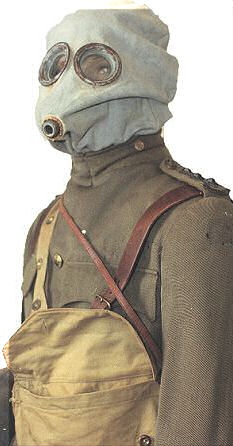 |
|
The PH Helmet. |
THE ANCRE: is a river in Picardy, France. It rises at
Miraumont, a hamlet near the town of Albert, and flows into the
Somme at Corbie.
BAPAUME: in 1916 Bapaume was one of the cities considered to
be strategic objectives by the allies in the framework of the Battle
of the Somme. The city was occupied by the Germans on the 26th
September 1914, then by the British on the 17th March 1917.
The Germans retook the city on the 24th March 1918 during their
Spring Offensive. The Second Battle of
Bapaume (21st August–3rd September 1918) was part of the second
phase of the Battle of Amiens. This British and Commonwealth
attack that was the turning point of the First World War on the
Western Front and the beginning of the Allies’
Hundred Days Offensive.
THE PH HELMET: was an early type of gas mask issued by the
British Army for protection against chlorine, phosgene and tear
gases. Rather than having a separate filter for removing the
toxic chemicals, it consisted of a gas-permeable hood worn over the
head which was treated with chemicals. The PH Helmet replaced
the earlier Tube Helmet in October 1915. Added hexamethylene
tetramine greatly improved protection against phosgene and added
protection against hydrocyanic acid. Around 14 million were
made and it remained in service until the end of the war by which
time it was relegated to second line use.
|
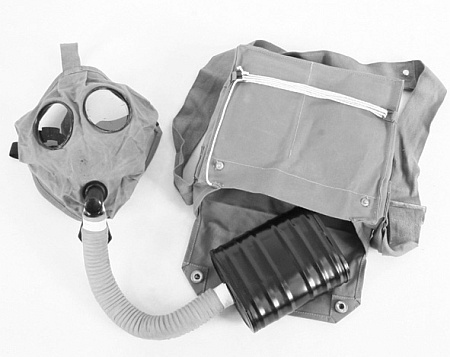 |
|
The Small-box
Respirator. |
THE SMALL-BOX RESPIRATOR: introduced in 1916, it was much
more sophisticated than earlier types. It consisted of a face
piece and a filter box, connected by a corrugated tube. The
small-box respirator was carried in a canvas bag, normally on the
soldier’s chest. In the event of a gas alarm, the soldier
fastened the respirator against his face, leaving the filter box in
the canvas bag. When the soldier inhaled, he drew air through the
filter box, where it was decontaminated before passing through the
corrugated tube and into the facemask.
THE CHILDERS REFORMS: restructured the infantry regiments of
the British Army. The reforms, undertaken by Secretary of
State for War Hugh Childers, were a continuation of the
earlier Cardwell Reforms. They came into effect on the 1st
July 1881.
The reorganisation was brought into effect by General Order 41/1881,
issued on the 1st May 1881, amended by G.O. 70/1881 dated the 1st
July, which created a network of multi-battalion regiments. In
England, Wales and Scotland, each regiment was to have two regular
or “line” battalions and two militia battalions. In Ireland,
there were to be two line and three militia battalions. This
was done by renaming the numbered regiments of foot and county
militia regiments. In addition the various corps of county
rifle volunteers were to be designated as volunteer battalions.
Each of these regiments was linked by headquarters location and
territorial name to its local “Regimental District”.
VADs: in 1909 the War Office issued the Scheme for the
Organisation of Voluntary Aid. Under this scheme the British
Red Cross were given the role supporting the Territorial Forces
Medical Service in the event of war. They did this by
recruiting volunteers, called “voluntary aid detachment members”,
who came to be known simply as ‘VADs’ (the term also applied to
voluntary aid detechments). VADs were trained in first aid and
nursing, and proved invaluable during both world wars.
THE RACE TO THE SEA: following
the September battles of the Marne and Aisne, the Race to the Sea
was conducted by Allied and German forces from September to November
1914. It was the last mobile phase of the war on the Western
Front and ended with the onset of trench warfare that would continue
until the German Spring Offensive of March 1918.
In the Race to the Sea, both sides attempted to outflank their
opponent by pressing their attacks increasingly further north in
Flanders, the only flank open for manoeuvre, but all attempts were
thwarted as each side dug in and prepared effective trench defences.
Once the trench lines had reached the the coast, the focus switched
to the opposite direction all the way to the (neutral) Swiss border,
some 400 miles in length. Deemed something of a draw by the
close of November, each side then settled down to protracted trench
warfare punctuated by periodic concerted attempts (such as the
Somme, the 2nd Aisne and Passchendaele) to break through the enemy line.
THE WESTERN FRONT: the main theatre of war during the First
World War. Following the outbreak of war in August 1914, the
German Army opened the Western Front by invading Luxembourg and
Belgium, then gaining military control of important industrial
regions in France. The tide of the advance was dramatically
turned with the Battle of the Marne (6th–10th September 1914).
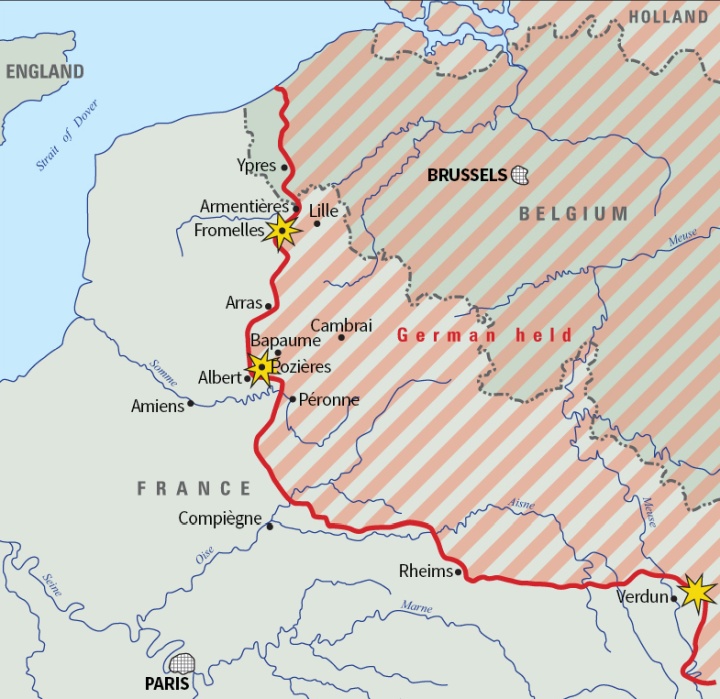
The Western Front in 1916.
Following the Race to the Sea (below), both sides dug in along a
meandering line of fortified trenches, stretching some 400 miles
from the North Sea to the Swiss frontier with France. Except
during early 1917 and in 1918, the Western Front changed little.
CAVALRY IN THE MIDDLE EASTERN WAR: General Chauvel, Commander of
the British Desert Mounted Column, and his 33,000 strong cavalry,
defeated two Turkish armies from Cairo to Damascus and beyond during
the Middle East War (1916-1918). He and his horsemen then
swept across the Jordan Valley and helped T. E. Lawrence (of Arabia)
and company put a third Turkish army asunder. The type of
horse Chauvel used was the Waler, a term derived from New South
Wales when the breed was scattered and developed all over Australia.
The Waler stood from 12 to 19 hands, usually in the range 14 to 16
hands, and weighed between 300kg and 750kg, sometimes more.
They were originally sired by English thoroughbreds from breeding
mares, which were often partly draught horse, and were versatile,
hardy animals that could withstand the rigours of Australia’s vast,
semi-desert regions.
MALARIA: an unexpected adversary in the First World War was malaria.
It attacked all combatant armies with adverse consequences for many
troops. Statistics for British and Dominion troops serving in
Egypt and Palestine in the period 1914-1918 show that out some
40,000 cases of malaria, 854 (2.13%) were fatal (Casualties and Medical Statistics of the Great War.
1931, London: HMSO).
When bitten by a malaria-infected mosquito, the parasites that cause
malaria are released into the person’s blood infecting the liver
cells. The parasite reproduces in the liver cells, which then
burst open to allow thousands of new parasites to enter the
bloodstream and infect red blood cells.
Malaria can affect different people in different ways, and no two
infections are identical. So while malaria kills, it can cause
death in different ways (and these conditions can strike in
combination, further reducing the survival prospects of sufferers):
One serious condition is called cerebral malaria,
caused when malaria parasites stick in the blood vessels in the
brain leading to deep coma, seizures and death. This affects
really young kids the most, usually when they are still babies and
is a very serious illness.
Another problem during malaria infection is severe anemia,
which is due to not having enough red blood cells to carry oxygen
around the body. Malaria infection causes the destruction of
red blood cells in the body, and also interferes with the body’s
ability to make new red blood cells. So the body becomes
starved of oxygen which can lead to death.
Malaria infection can also damage the lungs, and cause massive
breathing difficulties. Patients affected this way often take
huge deep breaths, almost like they are so hungry for air they can’t
get enough in and out of their lungs fast enough. This is
called respiratory distress, and one is the
worst signs for malaria patients.
It is no coincidence that both of the discoverers of the cause
of malaria and the carrier of the disease were military
surgeons serving in tropical countries, for armies have always been
plagued by the disease. In 1880, Charles Laveran, a French
army surgeon stationed in Algeria, was the first to notice parasites
in the blood of a patient suffering from malaria, but it was Ronald
Ross, a British Army surgeon working in Calcutta in 1897, who
discovered the role of the malaria carrying Anopheles mosquito in
spreading the disease.
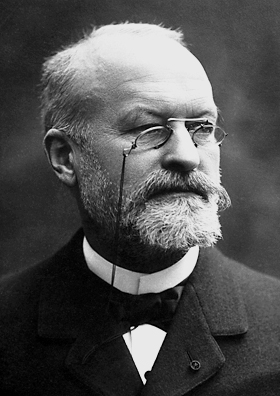 |
 |
|
Charles Louis Alphonse
Laveran
(1845-1922) |
Sir Ronald Ross FRS
(1857-1932) |
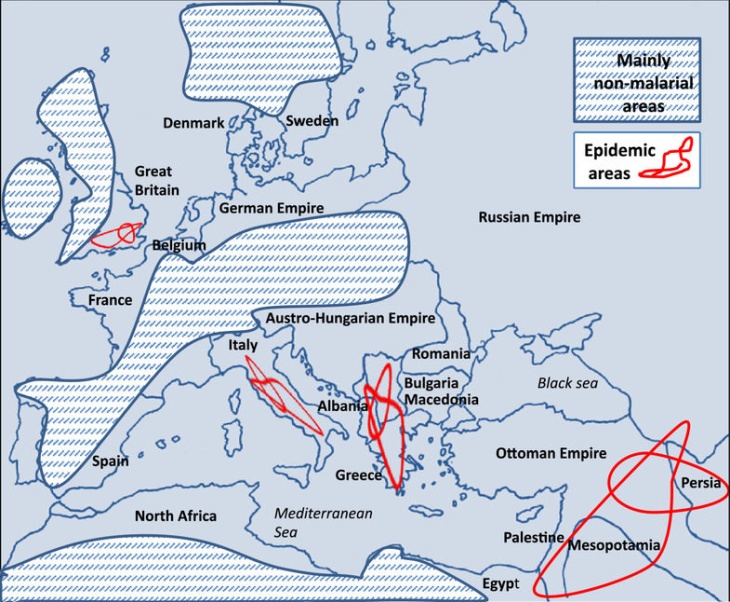
Distribution of malaria transmission in
theatres of the First World War.
During the First World War the only effective treatment for malaria
was the drug quinine, an extract from the bark of a South American
Cinchona Tree. Soldiers thought to be at risk
in malarious countries received a systematic treatment of quinine,
but the drug could have side effects such as tinnitus (a persistent
ringing in the ears) which many found difficult to tolerate, whilst
other distressing side effects were giddiness, blurred vision,
nausea, tremors and depression.
RHEUMATIC FEVER (RF): is an
inflammatory disease that can involve the heart, joints, skin, and
brain. Although its exact cause is unknown, the disease
usually follows the contraction of a throat infection caused by a
member of the Group A streptococcus bacteria (called strep throat).
Penicillin remains the most effective treatment for RF (although
this drug was not widely available for military use until 1944).
The long-term prognosis of an RF patient depends primarily on
whether he or she develops carditis (inflammation of the heart
muscle) the only manifestation of RF that can have permanent
effects. Those patients with mild or no carditis have an
excellent prognosis. Those with more severe carditis have a
risk of heart failure, as well as a risk of future heart problems
(which today may lead to the need for valve replacement surgery).
TRENCH FOOT: is a medical
condition caused by prolonged exposure of the feet to damp,
unsanitary, and cold conditions. The foot become numb, changes
colour, swells and starts to smell due to damage to the skin, blood
vessels and nerves. It can take three to six months to recover
fully, and prompt treatment is essential to prevent gangrene and
possible foot amputation.
Trench foot can be prevented by keeping the feet clean, warm, and
dry. It was also discovered in World War I that a key
preventive measure was regular foot inspections; soldiers would be
paired and each made responsible for the feet of the other, and they
would generally apply whale oil to prevent trench foot. If
left to their own devices, soldiers might neglect to take off their
own boots and socks to dry their feet each day, but if it were the
responsibility of another, this became less likely. Later on
in the war, instances of trench foot began to decrease, probably due
to the introduction of the aforementioned measures; of wooden
duckboards to cover the muddy, wet, cold ground of the trenches; and
of the increased practice of troop rotation, which kept soldiers
from prolonged time at the front.
WAR DIARY: is a regularly
updated official record kept by military units of their activities
during wartime. Their purpose is to record information which
can later be used by the military to improve its training and
tactics as well as to generate a detailed record of units’
activities for future use by historians.
The British Army first required its units to keep war diaries in
1907 as a means of preventing its mistakes of the Second Boer War
from being repeated. The First World War diaries − many of
which are held in the
National Archives and are available (for a fee) to download −
contain a wealth of information that has proved of far greater
interest than the army could ever have predicted. They provide
unrivalled insight into daily events on the front line, and are full
of fascinating detail about the decisions that were made and the
activities that resulted from them. While war diaries focus on
the administration and operations of the units they cover, they
follow no absolutely consistent format. Some record little
more than daily losses and map references whilst others are more
descriptive, with daily reports on operations, intelligence
summaries and other material. Diaries sometimes contain
information about particular people, including acts of gallantry,
but they are unit diaries, not personal diaries. That said,
officers that join or leave the unit or feature among its casualties
are are usually named whereas other ranks appear as totals (e.g.
42 ORs killed).
ARTILLERY: is a class of large
military weapons built to fire munitions far beyond the range and
power of infantry's small arms. Artillery is arguably the most
lethal form of land-based armament currently employed, and has been
since at least the early Industrial Revolution. The majority of
combat deaths in the Napoleonic Wars, World War I, and World War II
were caused by artillery.
The Royal Regiment of Artillery, commonly referred to as the
Royal Artillery (RA) and colloquially known as “The Gunners”, is
the artillery arm of the British Army. On the 1st July 1899,
the Royal Artillery was divided into three groups: the
Royal Horse Artillery (RHA) and Royal Field Artillery (RFA) comprised
one group, while the Coastal Defence, Mountain, Siege and Heavy
artillery were split off into another group named the Royal
Garrison Artillery (RGA). The third group continued to be
titled simply the Royal Artillery and was responsible for
ammunition storage and supply. During the First World War
there was a massive expanse in artillery, and by 1917 there were
1,769 batteries in over 400 brigades totalling 548,000 men.
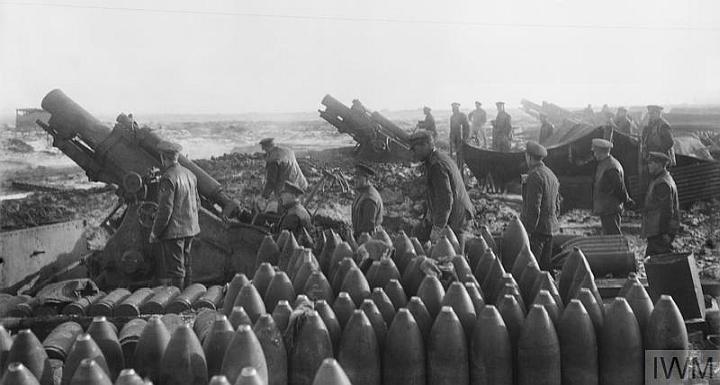
An RGA battery of 9.2 inch howitzers
with ammunition.
SIEGE BATTERY: the Royal
Garrison Artillery (RGA) became the ‘technical’ branch of the Royal Artillery
and was responsible for much of the professionalization of technical
gunnery that was to occur during the First World War. It was
armed with heavy, large calibre guns and howitzers that were
positioned some way behind the front line and had immense
destructive power. These sent large calibre high explosive
shells in high trajectory. The usual armaments were 6
inch, 8 inch and 9.2 inch howitzers, although some had huge railway-
or road-mounted 12 inch howitzers. As British artillery
tactics developed, Siege Batteries (of the RGA) were most
often employed in destroying or neutralising the enemy artillery, as
well as putting destructive fire down on strong-points, dumps,
store, roads and railways behind enemy lines.
Heavy and Siege Batteries were organised into Heavy Artillery
Brigades, a title that was altered to Heavy Artillery Groups
(HAGs) in April 1916, but reverted to Brigades in December 1917.
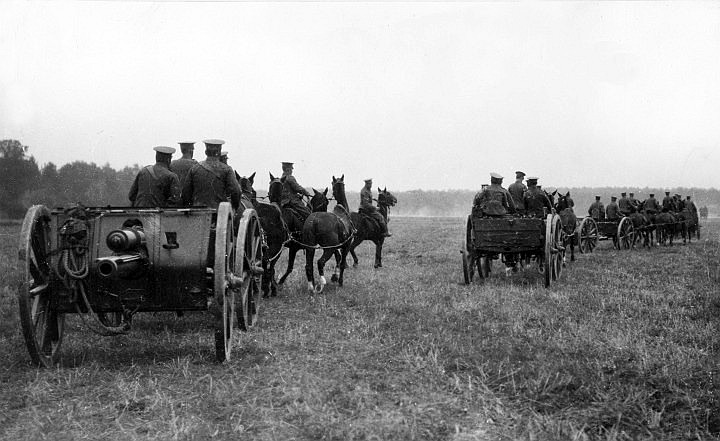
An RFA 18-pounder battery on the move.
The RFA, the
largest branch of the artillery, provided howitzers and medium
artillery near the front line. The Ordnance QF 18-pounder
(shown above), or simply 18-pounder, was the standard British field
gun of the First World War-era and was produced in large numbers.
It was used by British Forces in all the main theatres. Its
calibre (84 mm) and shell weight were greater than those of the
equivalent field guns in French (75 mm) and German (77 mm) service.
It was generally horse drawn until mechanisation in the 1930s.
|